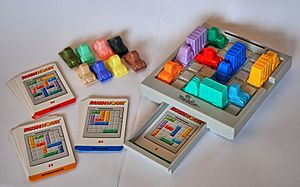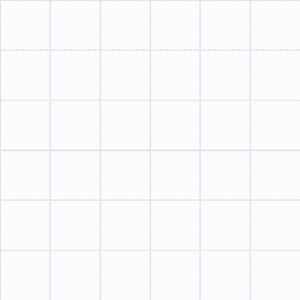Rush Hour (puzzle) facts for kids
Rush Hour is a cool sliding block puzzle! It was created by Nob Yoshigahara in the 1970s. This fun game first came out in the United States in 1996. Today, a company called ThinkFun makes it.
ThinkFun also makes other versions of the game. These include Rush Hour Jr., Safari Rush Hour, and Railroad Rush Hour. There are even more like Rush Hour Brain Fitness and Rush Hour Shift.
About the Game
The Regular Edition of Rush Hour comes with 40 puzzles. These puzzles are split into four levels, from Beginner to Expert. The Deluxe Edition has a black game board. It also includes 60 brand new puzzles. These puzzles have an extra difficulty level called Grand Master. This level is even harder than Expert!
The Ultimate Collector's Edition has a black board too. It can hold vehicles not being used in the game. This edition also has 155 new puzzles. Some of these puzzles are from older card sets. The Regular Version of the game comes with a travel bag. You can also buy extra puzzle card packs. These packs add even more challenges to your game!
What's in the Box?
The game board is a 6x6 grid. It has special grooves that let the cars slide easily. There's also a spot to hold your puzzle cards. The board has an exit hole where your main car needs to escape.
The game comes with 16 vehicles. These include 12 cars and 4 trucks. Each vehicle has a different color. Cars are two squares long. Trucks are three squares long. You can only move vehicles in a straight line. You cannot turn them. Each puzzle card shows you how to set up the cars and trucks. Not all vehicles are used in every puzzle.
Your Goal
The main goal of Rush Hour is simple. You need to get the red car out of the board. It must go through the exit hole. To do this, you have to move other vehicles out of its way. The cars and trucks block the path. This makes the puzzle a fun challenge!
More Puzzles and Cars
There are three official expansion packs for Rush Hour. They are called "add-on packs."
- Card Set 2 comes with a red sports car. This car takes up two squares.
- Card Set 3 includes a white limo. This limo takes up three squares.
- Card Set 4 has a taxi. This taxi also takes up two squares.
Each of these sets also gives you 40 new challenges. These puzzles range from Intermediate to Grand Master. They use the new vehicles. All three expansion packs work with any edition of the game. This includes the Regular, Deluxe, and Ultimate Collector's Editions.
In 2010, an iOS version of the game was released. This means you can play it on your Apple devices!
Hardest Puzzles
People have figured out the hardest starting setup for Rush Hour. It takes 93 steps to solve this puzzle. You can see a picture of its shortest solution on the right.
If you count how many times you need to move a car, the hardest puzzle needs 51 moves.



